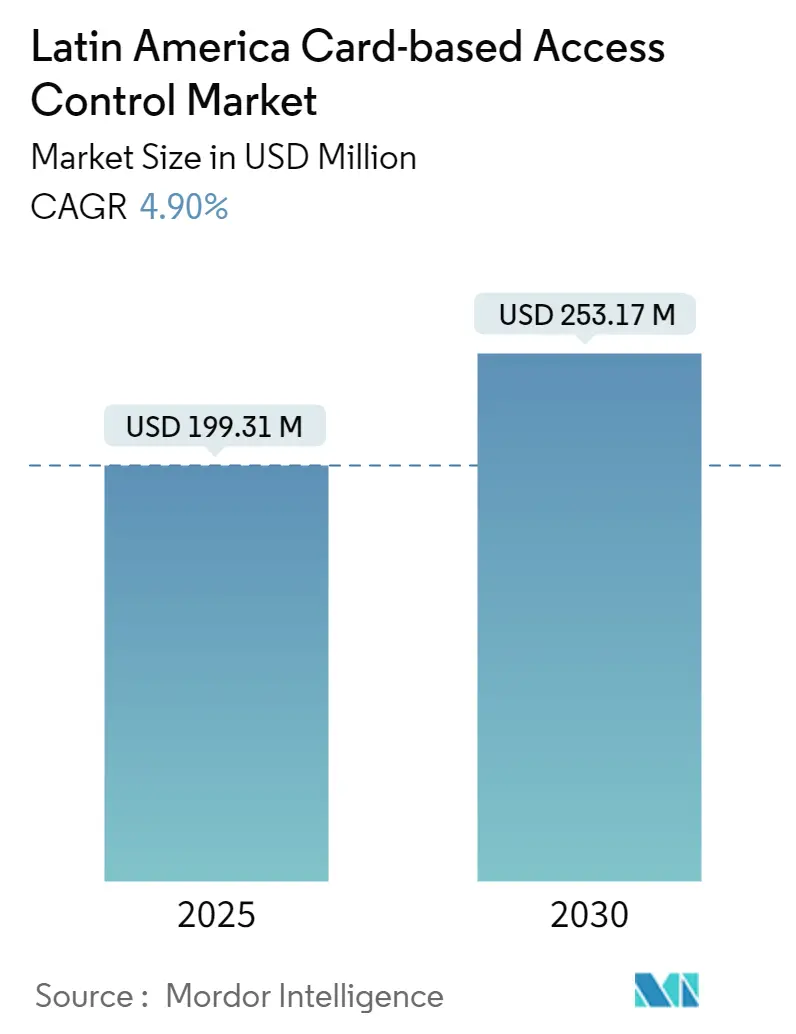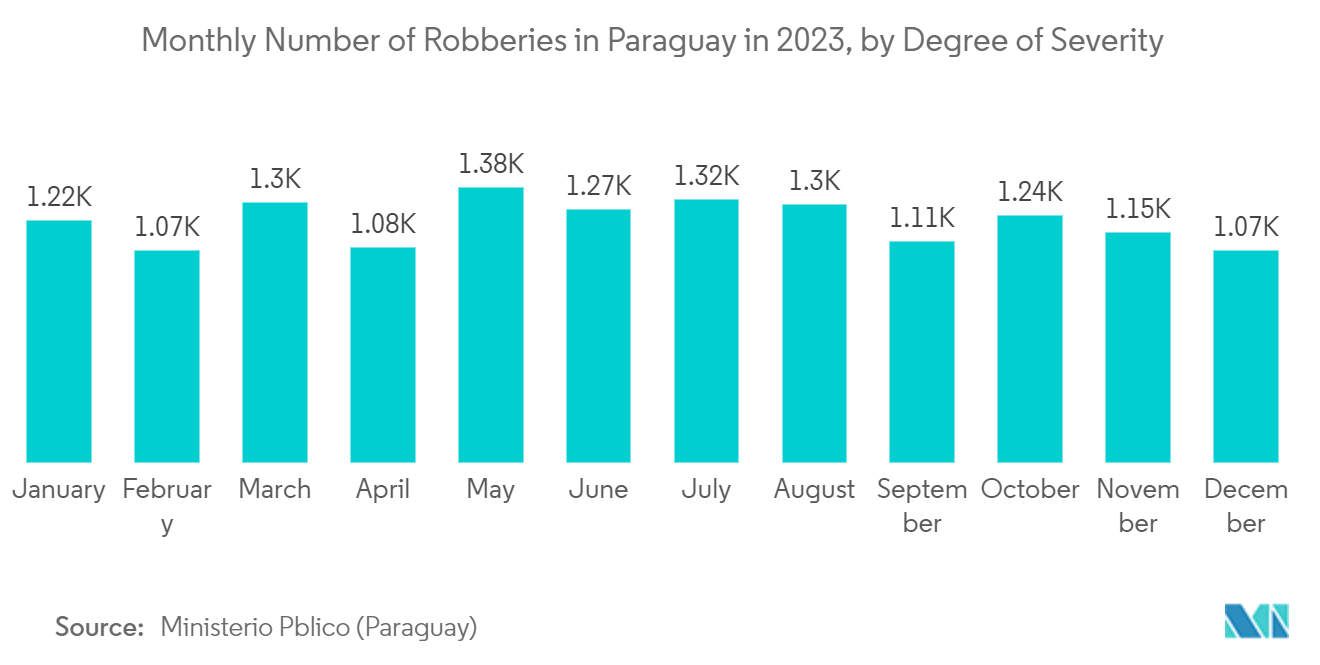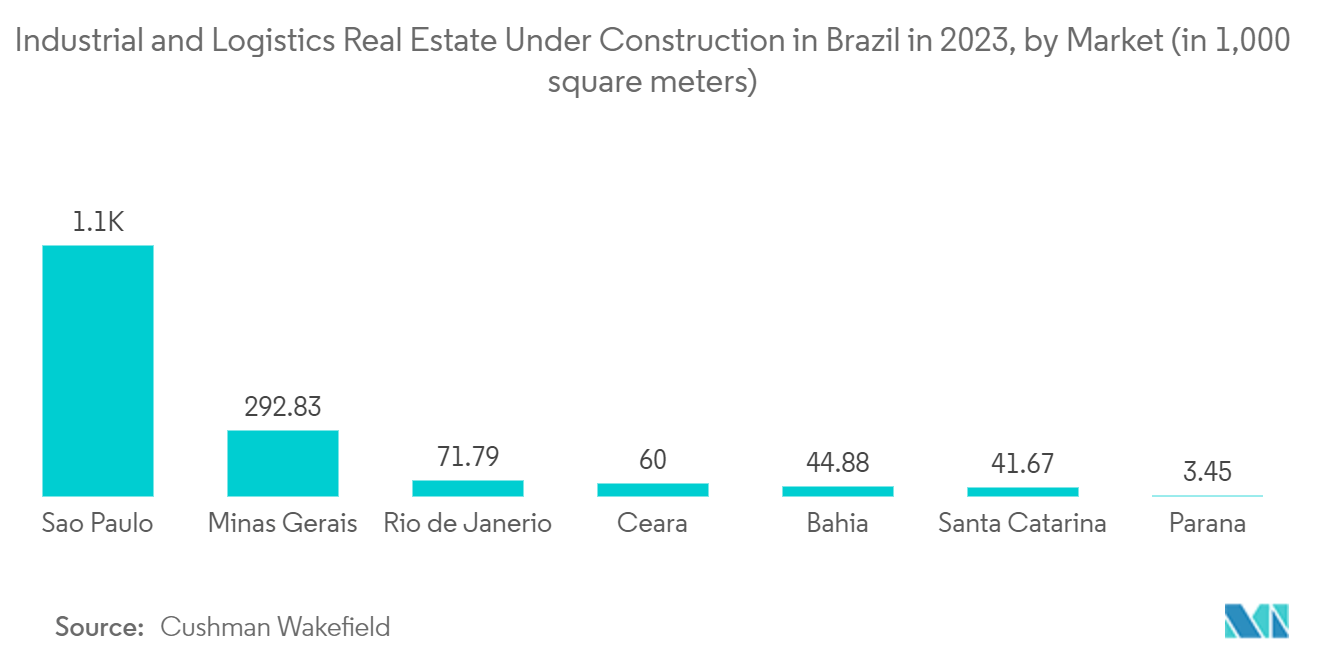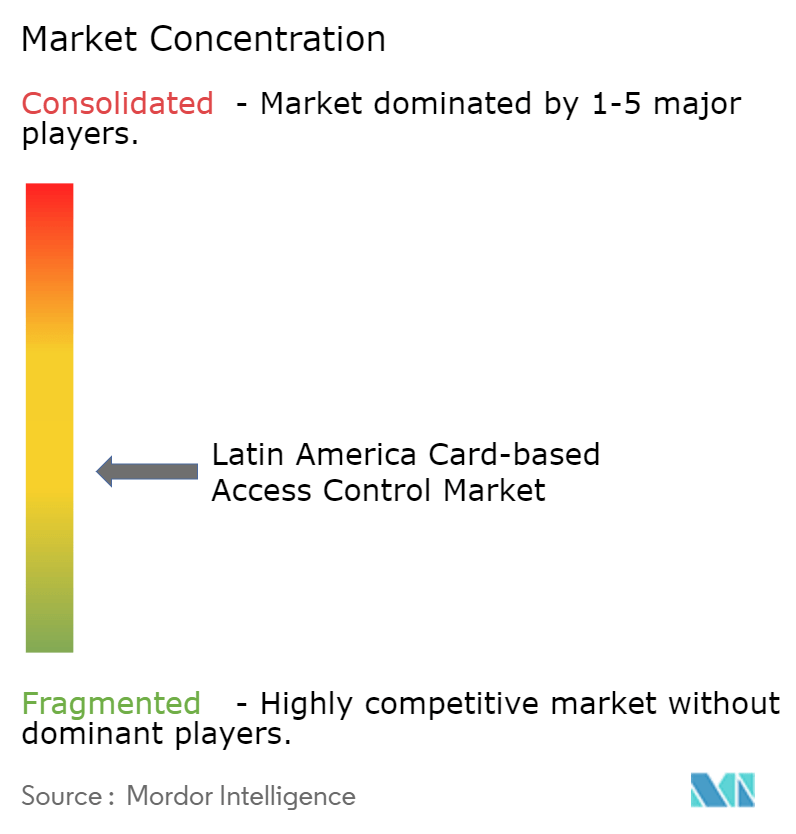Latin America Card-based Access Control Market Size and Share

Latin America Card-based Access Control Market Analysis by Mordor Intelligence
The Latin America Card-based Access Control Market size is estimated at USD 199.31 million in 2025, and is expected to reach USD 253.17 million by 2030, at a CAGR of 4.9% during the forecast period (2025-2030).
- In a card-based access system, multiple components work together. Among these, the access control card reader stands out as pivotal. It is responsible for scanning data from the key card or fob and deciding on access permissions. Card-based access control systems are now a cornerstone of contemporary security measures. They empower businesses to oversee and regulate facility access, offering this control remotely from any corner of the globe, ensuring security and operational efficiency.
- Increasing construction and infrastructure projects, alongside a surge in criminal activities, are driving the demand for card-based access control systems in Latin America. Governments are ramping up investments to combat rising crime rates, notably through the deployment of access control systems.
- For instance, in December 2023, the Federal Government introduced the "Routes for Integration" initiative. This project is expected to receive around USD 10 billion in funding from development banks to create a network of routes to promote South American integration and development. The main goal is to shorten distances, enhance logistics, simplify connections, and increase productivity. The infrastructure developments consist of infoways, hydroways, roadways, railways, ports, airports, and electricity transmission lines.
- Modern apartment buildings often feature a range of amenities, from pools and fitness centers to conference rooms and mailrooms. Securing these spaces is paramount. By installing readers at their entrances, buildings can restrict access to only approved tenants and staff. Controlled access buildings may also need security measures for areas like parking garages, elevators, server rooms, and equipment spaces.
- The lack of public awareness and operational concern of newly created wireless locks that can be operated with cards, as well as their expanded benefits when combined with the cloud, pose a barrier to the expansion of this market.
- The card-based access control market in Latin America is semi-consolidated, with less number of players occupying a moderate level of market share. Vendors operating in the market are focusing on new product development, strategic partnership, acquisition, and expansion to meet the growing demand from the customers, further supporting the market’s growth.
- Furthermore, smart city initiatives are gaining momentum in Latin America. The governments in the region are increasingly turning to technology for urban development, a move that is set to drive up the demand for card-based access control systems in the coming years.
- The availability and reliability of card-based access control systems are greatly influenced by macroeconomic factors like government regulations on import/export. These regulations differ across nations, often demanding thorough certifications, testing, and compliance with particular standards. Despite their goal of ensuring safety and quality, these regulations can present substantial obstacles for manufacturers, distributors, and consumers. Delays in card-based access control system availability due to import/export rules can impede their prompt deployment in different end-user sectors.
Latin America Card-based Access Control Market Trends and Insights
Smart Card (Contact and Contactless) Segment Expected to Witness High Growth
- Smart cards are designed with the intention of being difficult to replicate. They offer features such as personal identification, authentication, data storage, and application processing and can be integrated with other card technologies to enhance security measures.
- The use of smart cards has increased in the past few years, and the trend is expected to continue, with contactless smart cards gradually replacing older technology proximity cards. Smart cards have had far more use cases due to their reduction in costs while deploying and growing ease of technology use cases. Human physical intervention has been eliminated in large amounts in the operations of these access control technologies.
- The demand for smart cards in Latin America is increasing as customers are actively looking for total security solutions and flexible door environments using convenient digital and mobile technology. This is possible due to various advancements and usage in authentication methods like RFIDs.
- Reducing and eliminating theft is a major benefit considered when replacing traditional locks and keys with smart cards. Smart card access control systems tend to be much more reliable and durable than mechanical locks and metal keys.
- The rise in criminal incidents in the region is expected to drive up the need for smart cards between 2024 and 2029. Data from Ministerio Público (Paraguay) revealed that by December 2023, there were approximately 416 reported cases of robbery and more than 1,065 cases of aggravated robbery in Paraguay. May stood out as the month with the highest number of aggravated and common robbery cases, with 1,380 and 596 incidents, respectively.

Brazil is Expected to Register the Fastest Growth
- The rising need for access control in government, industrial, commercial, residential establishments, and transportation hubs is set to drive deeper integration of card-based access control systems across Brazil. This integration is expected to enhance security measures, improve monitoring capabilities, and provide efficiency to the organizations.
- Key card or key fob systems serve as vital access control tools, aiding IT and security teams in safeguarding their facilities. They enable access to offices and buildings while also thwarting security breaches and unauthorized entries.
- The rising need for physical security in establishments has driven a notable uptick in the adoption of card-based access control systems by businesses. This upswing in the market directly mirrors the escalating demand for heightened security and protection in various end-user industries, including industrial, healthcare, and commercial.
- The expanding construction activities in the country are anticipated to create more demand for the card-based access control market. According to the Brazilian Institute of Geography and Statistics, the gross domestic product (GDP) of the construction industry in Brazil was significantly higher in 2023 than in the previous year.
- Similarly, according to the statistics provided by Cushman & Wakefield, in 2023, Sao Paulo spearheaded Brazil's industrial and logistics real estate construction, claiming over two-thirds of the nation's projects. Specifically, São Paulo saw nearly 1.1 million square meters of space under construction, highlighting its pivotal role in the country's real estate development.

Competitive Landscape
The Latin American card-based access control market has various major players that have been using various strategies, such as new product launches, joint ventures, expansions, partnerships, acquisitions, etc., to increase their footprints in this market, which intensifies market rivalry. The market is semi-consolidated. Some of the key players are ADT LLC, Allegion PLC, ASSA ABLOY AB, HID Global Corporation, and Axis Communications AB.
Latin America Card-based Access Control Industry Leaders
-
ADT LLC
-
Allegion plc
-
ASSA ABLOY AB
-
HID Global Corporation
-
Axis Communications AB
- *Disclaimer: Major Players sorted in no particular order

Recent Industry Developments
- June 2024: Honeywell completed the acquisition of Carrier Global Corporation's Global Access Solutions business for USD 4.95 billion. This move cements Honeywell's status as a leading provider of security solutions for the digital age, paving the way for accelerated innovation in the fast-growing cloud-based services and solutions industry. Furthermore, this transaction reinforces Honeywell's strategic alignment around three key megatrends, including automation, and complements its Building Automation segment.
- January 2024: SecuGen revealed its latest product, the SecuGen IQ SC1 contact smart card reader. This marks the company's debut in the standalone smart card reader market. The reader is equipped with a USB full-speed interface and is capable of reading and writing smart cards at a maximum speed of 600 kbps. According to the company, the device has a lifespan of up to 200,000 card insertion cycles.
Latin America Card-based Access Control Market Report Scope
Card access control systems, commonly referred to as key fob access control systems, are electronic door security systems. They employ card readers in conjunction with key fobs to regulate access to designated areas within a building or facility. The study tracks the revenue accrued through the sale of card-based access control products by various players in Latin America. It also covers the key market parameters, underlying growth influencers, and major vendors operating in the market, which supports the market estimations and growth rates over the forecast period. The study further analyses the overall impact of COVID-19 aftereffects and other macroeconomic factors on the market. The report's scope encompasses market sizing and forecasts for various market segments.
The Latin American card-based access control market is segmented by card type (swipe cards, RFID proximity cards, and smart card [contact and contactless], component (card readers, access control keypads, access control panel, and electronic lock hardware, and other components), end-user vertical (commercial, residential, government, industrial, transport and logistics, healthcare, military and defense, and other end-user verticals), and country (Brazil, Mexico, Argentina, and Rest of Latin America). The market sizes and forecasts are provided in terms of value in USD for all the above segments.
| Swipe Cards |
| RFID Proximity Cards |
| Smart Card (Contact and Contactless) |
| Card Readers |
| Access Control Keypads |
| Access Control Panels |
| Electronic Lock Hardware |
| Other Components |
| Commercial |
| Residential |
| Government |
| Industrial |
| Transport and Logistics |
| Healthcare |
| Military and Defense |
| Other End-user Verticals |
| Brazil |
| Mexico |
| Argentina |
| By Card Type | Swipe Cards |
| RFID Proximity Cards | |
| Smart Card (Contact and Contactless) | |
| By Component | Card Readers |
| Access Control Keypads | |
| Access Control Panels | |
| Electronic Lock Hardware | |
| Other Components | |
| By End-user Vertical | Commercial |
| Residential | |
| Government | |
| Industrial | |
| Transport and Logistics | |
| Healthcare | |
| Military and Defense | |
| Other End-user Verticals | |
| By Country*** | Brazil |
| Mexico | |
| Argentina |
Key Questions Answered in the Report
How big is the Latin America Card-based Access Control Market?
The Latin America Card-based Access Control Market size is expected to reach USD 199.31 million in 2025 and grow at a CAGR of 4.90% to reach USD 253.17 million by 2030.
What is the current Latin America Card-based Access Control Market size?
In 2025, the Latin America Card-based Access Control Market size is expected to reach USD 199.31 million.
Who are the key players in Latin America Card-based Access Control Market?
ADT LLC, Allegion plc, ASSA ABLOY AB, HID Global Corporation and Axis Communications AB are the major companies operating in the Latin America Card-based Access Control Market.
What years does this Latin America Card-based Access Control Market cover, and what was the market size in 2024?
In 2024, the Latin America Card-based Access Control Market size was estimated at USD 189.54 million. The report covers the Latin America Card-based Access Control Market historical market size for years: 2019, 2020, 2021, 2022, 2023 and 2024. The report also forecasts the Latin America Card-based Access Control Market size for years: 2025, 2026, 2027, 2028, 2029 and 2030.
Page last updated on:
Latin America Card-based Access Control Market Report
Statistics for the 2025 Latin America Card-based Access Control market share, size and revenue growth rate, created by Mordor Intelligence™ Industry Reports. Latin America Card-based Access Control analysis includes a market forecast outlook for 2025 to 2030 and historical overview. Get a sample of this industry analysis as a free report PDF download.



